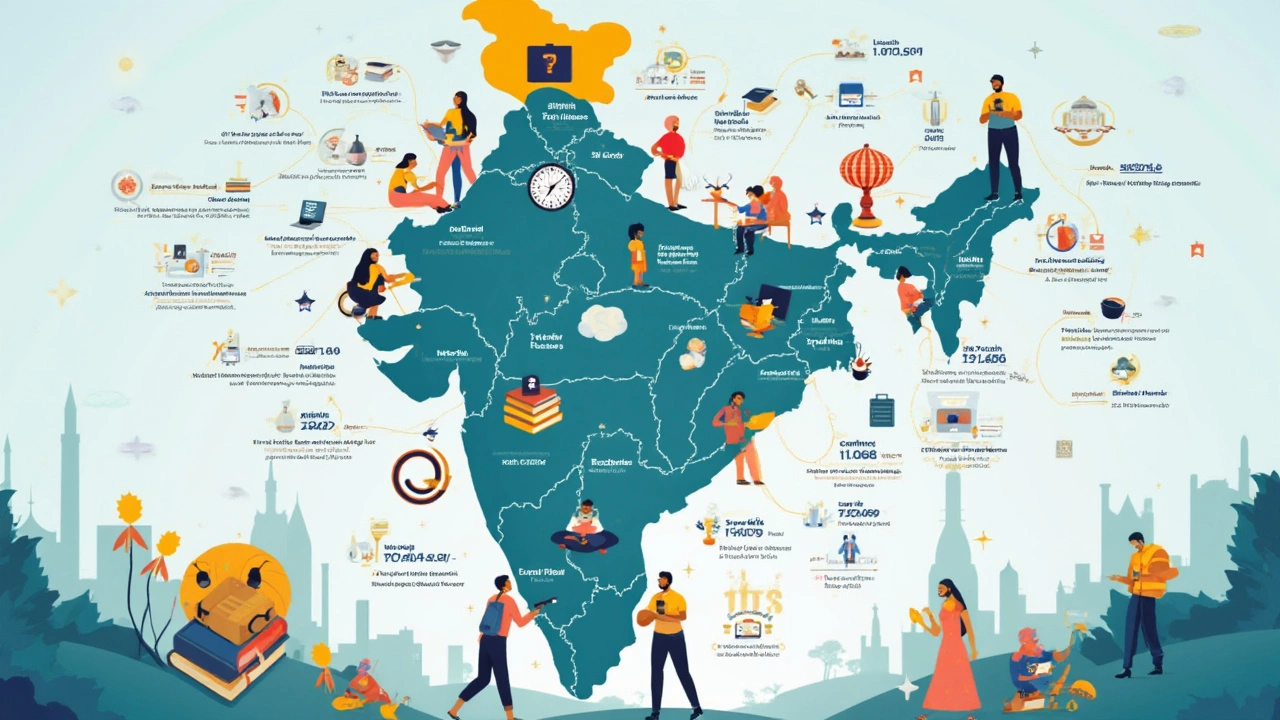Best State for Education: Where Competitive Exam Prep Shines
 May, 15 2025
May, 15 2025
If you’re grinding for competitive exams like the SAT, ACT, or AP tests, one question keeps popping up: does the state you live in really affect your odds? The answer—surprisingly, yes. States aren’t just random places on a map. Some have public schools and prep support that push test scores way above the national average. Others lag behind, leaving students to figure things out on their own. Knowing where the biggest advantages are can change the way you prep, even if you never set foot outside your hometown.
No one likes guessing games, especially with something this important. Massachusetts, for example, has consistently led the pack when it comes to average standardized test scores and graduation rates. But don’t just look at bragging rights. Dig deeper, and you’ll spot differences in resources, teacher experience, and even the pressure cooker “academic culture” that pushes students to aim higher. If you’re chasing a target score or aiming for a top college, the environment around you matters way more than you think.
- How States Stack Up: The Numbers
- What Sets Top States Apart
- Inside the Classroom: Study Hacks and Secrets
- Leveling Up—No Matter Where You Live
How States Stack Up: The Numbers
If you’re serious about figuring out which state offers the best state education for competitive exams, you need real numbers, not just reputation. Test scores, graduation rates, and access to advanced courses can look really different from one state to the next. Let’s break down where states actually stand by the data.
Year after year, Massachusetts makes headlines for holding the highest average SAT scores and AP participation rates. According to the College Board’s 2024 data, Massachusetts students scored an average SAT total of 1180, while the national average hovers closer to 1050. Nearby, states like New Jersey and Connecticut also land in the top five for both SAT scores and high school graduation rates. On the flip side, states in the deep South—like Mississippi and Louisiana—often end up toward the lower end of these charts.
| State | Avg SAT Score (2024) | High School Grad Rate (%) | AP Participation (%) |
|---|---|---|---|
| Massachusetts | 1180 | 93 | 61 |
| New Jersey | 1140 | 91 | 58 |
| Connecticut | 1120 | 90 | 56 |
| California | 1080 | 86 | 44 |
| Mississippi | 970 | 80 | 20 |
If you go by these stats, living in the Northeast gives you a leg up. More students there take AP classes, more graduate on time, and their SAT averages don’t dip below the national mean. States like Illinois and Minnesota also have solid numbers but just don’t grab as many headlines as the East Coast.
But don’t just chase scores. Some states have special grant programs, free prep courses, or more experienced teachers—things that matter just as much as averages. Checking your own state’s report card online can reveal hidden strengths, like a bigger push for STEM, or pilot programs for exam prep you didn’t know existed. So, while the numbers show Massachusetts leading the pack, it pays to take a closer look at what’s happening right in your backyard too.
What Sets Top States Apart
If you look at why some states stand out for education, the differences are not random luck. Top states like Massachusetts and New Jersey share certain qualities that put their students in the fast lane for competitive exams. It's not just about having good schools on paper—real advantages come from how these places build their education systems.
One big factor is how much money gets spent per student. In 2023, Massachusetts spent over $18,000 per student while Mississippi, for example, spent barely half that. This extra cash goes into updated textbooks, more AP course options, and qualified teachers who stick around longer. More resources mean better prep and less guesswork when big tests roll around.
Let’s talk about teachers. In high-ranking states, teachers get more professional development and usually have higher pay (think $83,000 a year on average in New York!). With less teacher turnover, students are less likely to get stuck with substitutes or out-of-field instructors right before exam day.
But it’s not all about dollars. There’s a powerful academic culture in top states that shows up as higher participation in honors and AP classes. For example, California has over 40% of its high schoolers taking at least one AP class. Schools give more info sessions, exam workshops, and after-school programs, making it normal instead of extra pressure to prep for big tests.
| State | Avg. SAT Score (2024) | Per-Student Spending | % Taking AP Exams |
|---|---|---|---|
| Massachusetts | 1252 | $18,162 | 39% |
| New Jersey | 1203 | $21,767 | 37% |
| California | 1162 | $17,702 | 41% |
| Mississippi | 1085 | $9,142 | 18% |
Notice that the best state education zones back up their rep with real stats. Students also benefit from stronger support outside the classroom, like guidance counselors who help with college essays and school libraries packed with exam prep guides. These advantages make a big difference—especially for students aiming for competitive exams.
- Check if your state offers free SAT/ACT tutoring or fee waivers.
- Find out how many AP courses and exam prep clubs your local high school runs.
- Don’t ignore your guidance counselors. They often have info on scholarships and practice test dates.

Inside the Classroom: Study Hacks and Secrets
The secret sauce for schools at the top of every best state education list? It comes down to what actually happens inside the classroom. Take Massachusetts—it's not just their test prep classes, but the focus on practice tests, targeted feedback, and peer support. Real talk: students there aren’t just memorizing facts. They’re running through mock exams and troubleshooting mistakes, right in class. This means they walk into real tests way more prepared and way less stressed.
Let’s look at what sets top performers apart. In states with higher average SAT and ACT scores, students get regular access to:
- Free or low-cost exam prep workshops after school.
- Teachers trained to break down questions, not just hand out answers.
- Peer study groups run by top scorers who share their tips.
- Weekly quizzes and timed drills, so you get used to the real thing.
And it’s not a rumor—schools in the Northeast actually schedule time for students to review past test questions, sometimes pulling practice sets straight from College Board releases.
| State | Reading & Writing | Math | Total |
|---|---|---|---|
| Massachusetts | 590 | 601 | 1191 |
| Connecticut | 580 | 595 | 1175 |
| California | 534 | 537 | 1071 |
| Texas | 520 | 510 | 1030 |
The biggest hack? Practice with intent. Don’t just take endless tests—focus on your weak spots. Students in winning states make a habit of reviewing every missed problem until they can teach it to someone else. Some high schools even have “exam analysis” sessions, where you team up with classmates to break down tough questions. It’s not just about working harder—it's about working smarter and copying what works from the best.
Leveling Up—No Matter Where You Live
Alright, so maybe you don’t live in Massachusetts. Don’t sweat it. The truth is, students everywhere are nailing competitive exams by using smart study moves and free tools. A killer strategy matters way more than your zip code.
First, online resources can totally close the gap. The College Board, Khan Academy, and even some TikTok tutors are packed with practice questions, walkthroughs, and honest advice. No fancy school required—just internet and some hustle.
- Set a regular study schedule: Most top scorers put in 3–5 hours a week just for test prep, spreading it out so nothing piles up last minute.
- Join or form a study group: Research from 2023 found students in small groups improved SAT scores by an average of 60 points compared to those solo grinding.
- Use practice exams: Time yourself. Analyze mistakes. Repeat. Actual SAT practice tests (available free) are the closest thing to the real deal.
- Get feedback early: Teachers might be busy, but don’t skip their office hours. One-on-one tips can give you a serious edge, especially on tricky subjects.
Access to books and guidance matters too, but libraries in every state now let you borrow SAT, ACT, and AP books for free. Some even offer exam prep workshops after school or on weekends. If you’re in a rural area, check if your school partners with state universities for remote tutoring or online classes.
Check out how much state support can differ, even for things like digital test prep and counseling:
| State | Free Digital Resources | Guidance Counselors Per 1000 Students |
|---|---|---|
| Massachusetts | Yes | 3.2 |
| Texas | Yes | 2.1 |
| Montana | Limited | 1.3 |
| Alabama | Yes | 1.5 |
At the end of the day, every student can compete at a high level. The state you’re in might hand you different tools, but your grind—using real practice materials, seeking feedback, and connecting with peers—always moves the needle.